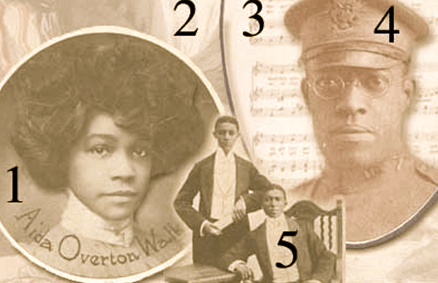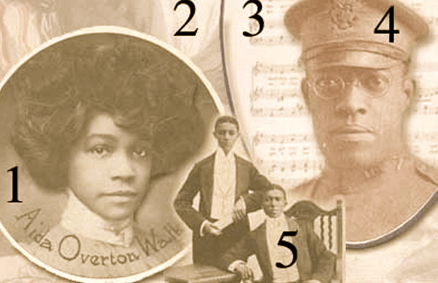African-American Sheet Music

African-American Sheet Music:
This collection consists of 1,305 pieces of African-American sheet music dating from 1850 through 1920. The collection includes many songs from the heyday of antebellum black face minstrelsy in the 1850s and from the abolitionist movement of the same period. Numerous titles are associated with the novel and the play Uncle Tom’s Cabin. Civil War period music includes songs about African-American soldiers and the plight of the newly emancipated slave. Post-Civil War music reflects the problems of Reconstruction and the beginnings of urbanization and the northern migration of African Americans. African-American popular composers include James Bland, Ernest Hogan, Bob Cole, James Reese Europe, and Will Marion Cook Twentieth century titles feature many photographs of African-American musical performers, often in costume.
Unlike many other sorts of published works, sheet music can be produced rapidly in response to an event or public interest, and thus is a source of relatively unmediated and unrevised perspectives on quickly changing events and public attitudes. Particularly significant in this collection are the visual depictions of African Americans which provide much information about racial attitudes over the course of the nineteenth and early twentieth centuries.
African-American Sheet Music

1. Why Adam Sinned [cameo portrait of Aida Overton Walker from cover], 1904. African-American Sheet Music Collection, Department of Special Collections, Brown University Library. Digital ID: http://hdl.loc.gov/loc.award/rpbaasm.1310
2. Background for collage Eva and Topsy [detail from cover], 1852. African-American Sheet Music Collection, Department of Special Collections, Brown University Library. Digital ID: http://hdl.loc.gov/loc.award/rpbaasm.1271
3. Music behind portrait Eva and Topsy, 1852. African-American Sheet Music Collection, Department of Special Collections, Brown University Library. Digital ID: http://hdl.loc.gov/loc.award/rpbaasm.1271
4. Good Night Angeline [cameo portrait of James Reese Europe from cover], 1919. African-American Sheet Music Collection, Department of Special Collections, Brown University Library. Digital ID: http://hdl.loc.gov/loc.award/rpbaasm.1148
5. The Luckiest Coon in Town [cameo portrait of Bob Cole and Billy Johnson from cover], 1909. African-American Sheet Music Collection, Department of Special Collections, Brown University Library. Digital ID: http://hdl.loc.gov/loc.award/rpbaasm.0285
African-American Sheet Music, 1850-1920
Why Adam sinned / words and music by Alex Rogers. Rogers, Alex.
OTHER TITLES First line of text: I heard de ol’ folks talking’ First line of chorus: Adam never had no Mammy for to take him on her knee.
NOTES For voice and piano.
At head of title: A quaint idea set to music.
“Featured by Aida Overton Walker.”
Title page illustration: snake offering apple to statue of Eve on a pedestal; cameo photo. of Aida Overton Walker.
Advertisement for another song (with 1st p. of music) on p. [2]: Nobody / music by Bert A. Williams.
Advertisement for 7 songs from the musical Bandana Land (with incipits) on p. [6]: Fas’ fas’ world; Late hours; Just the same; Bon bon buddy; It’s hard to love somebody; Bandana Land; Dinah.
Originally published: N[ew] Y[ork] City: Gotham-Attucks Music Co., c1904
Topsy’s song / written by Charles Jefferys; co[m]posed by Stephen Glover.
Glover, Stephen, 1813-1870.
OTHER TITLES First line of text: I’m but a little nigger gal.
NOTES For voice and piano.
Lithographed t.p.: Eva and Topsy seated and holding hands, with red and white roses; Corbaux del et lith.; Stannard & Dixon Imp.
Advertisement for Jefferys edition of songs from “Uncle Tom’s cabin,” written and composed by Charles Jefferys and Stephen Glover: p. [8].
Originally published: London: C. Jefferys, c1852.

Goodnight Angeline / James Reese Europe, Noble Sissle, Eubie Blake.
Europe, James Reese, 1881-1919.
OTHER TITLES First line of text: Hear dat ole town clock a-striking, Angeline. First line of chorus: Goodnight, my Angeline. NOTES For voice and piano.
Caption title. Joint composer’s name appears as Noble Sessle on cover.
Advertisement for another song: p.
Cover illustration: drawing of band instruments; photographs of James Reese Europe and the 369th U.S. Infantry “Hell Fighters” Band.
Originally published: New York: M. Witmark & Sons, c1919









